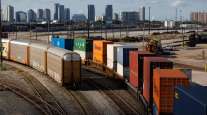Shippers Support Higher Truck Weights, More Rail Competition at House Hearing
This story appears in the Oct. 7 print edition of Transport Topics.
Heavier allowable truck weights and greater competition in the railroad industry would improve freight operations and make U.S. manufacturers more competitive globally, representatives of large shippers told a congressional panel last week.
Trucks at International Paper Co. reach their weight limits long before they are completely filled, said Tom Kadien, the manufacturer’s senior vice president of consumer packaging.
“With 300,000 trucks going over the road, it doesn’t make a lot of sense to us to send trucks with 10 feet of empty space when there are safe alternatives to increase truck weights,” Kadien told the panel.
He testified at a hearing on 21st Century Freight Transportation on Oct. 1, the first day of the federal government shutdown.
Rep. Bill Shuster (R-Pa.), chairman of the House Transportation and Infrastructure Committee, created the special panel to explore freight issues before Congress starts work next year on a transportation reauthorization bill.
Several other shipper witnesses said that a lack of competition among railroads has led to high transportation rates, which has made them less able to compete in world markets.
Meanwhile, Rep. Jerrold Nadler (D-N.Y.), told the panel, “I hope the irony is not lost on my colleagues that these witnesses are testifying about the importance of the federal government in the middle of a Republican government shutdown.”
“All of the work of this committee will be for nothing unless these shenanigans stop and we get back to doing the business of the American people,” Nadler said.
The hearing was one of several the freight panel has held this year, and its chairman, Rep. John Duncan Jr. (R-Tenn.), said its findings will be presented to the T&I committee later this month.
Kadien and others told the panel that Congress should pass legislation to allow states to decide whether they want trucks weighing up to 97,000 pounds with six axles to run on their interstate highways.
Currently, trucks are limited to 80,000 pounds on interstates, except where Congress has allowed exemptions to the rule, such as in Maine, Vermont and some Western states.
Nadler took issue with the idea that states, rather than the federal government, should decide whether to allow heavier trucks on interstate highways.
“We know that interstate bridges cannot withstand the stress that 97,000-pound trucks will cause, even with the addition of the sixth axle,” Nadler said. “These trucks will accelerate the deterioration of, and further worsen, the condition of our nation’s bridges.”
Nadler and Rep. Corrine Brown (D-Fla.) said that federal money, in some cases up to 90% of a project’s cost, pays for construction and maintenance of the bridges, and Congress is wrestling with how to find long-term funding for that work.
“As we meet today, one of my bridges has been taken out,” Brown said, referring to the Mathews Bridge in Jacksonville, Fla. The span, which carried 56,000 vehicles a day, had to be closed indefinitely Sept. 26, after a tanker ship passing underneath sliced one of the bridge’s steel beams.
Brown asked the witnesses how to adequately fund the nation’s infrastructure, and when one responded that he didn’t have the answer, she acknowledged, “We don’t have it, either.”
Witness William Roberson, materials and logistics manager for Nucor Steel, called on Congress to foster competition among railroads. That way, firms such as his wouldn’t have to pay higher rail rates to get products to market because they’re served by only one railroad, he said.
“We cannot pass these increased costs on to our customers,” Roberson said. “We have to absorb them because we compete in a steel market that is being flooded with illegally subsidized foreign products that are often already sold for low costs.”
Edmond Johnston III, sustainability manager for DuPont, said that company and other chemical manufacturers also are forced to pay high rail rates that increase the cost of their products.
“Chemical producers report that 73% of their facilities with inbound and 65% with outbound transportation are captive shippers, meaning they are only served by one railroad,” Johnston said, testifying for DuPont and the American Chemistry Council.
Thirty years ago, Congress passed legislation to bolster and protect a weak railroad industry by allowing it more control over its rate setting, but today, railroads no longer need protection and should be subject to a more competitive marketplace, Johnston said.
The policy has been so successful, he added, “that the question in 2013 is not whether America will have a viable railroad transportation system but whether that
system will threaten the competitiveness of the railroads’ customers and become an inhibitor of economic growth.”
Bill Reid, vice president of public affairs at Riceland Foods, a cooperative of rice farmers, told the panel that the cooperative needs railroads, highways and rivers to get products to market.
However, the modes face various challenges, he said. For example, the eastern Arkansas area that the cooperative calls home is dotted with bridges labeled deficient.


